#chasmosaurus fossils
Explore tagged Tumblr posts
Text
The Significance of Complete Dinosaur Fossils in Scientific Research
Complete fossils of dinosaurs can be considered among the precious sources of treasures in paleontology. These offer information that is often not represented by incomplete specimens. With the hundreds of fossilized dinosaurs found each year, only a few could be recorded as complete. Complete fossils helped advance our knowledge about prehistoric life. For more information visit :- https://ext-6319318.livejournal.com/3301.html

#dinosaur fossils#ammonite fossils#mammal fossils#fossils#spinosaurus fossils#dinosaurs#buy real fossils#chasmosaurus fossils#fish fossils#edmontosaurus teeth
9 notes
·
View notes
Text
daily vivosaur 2
Genus: chasmosaurus
the vents on this vivosaurs frill make them particularly light, this can agitate the opponenets and make them unable to move in battle
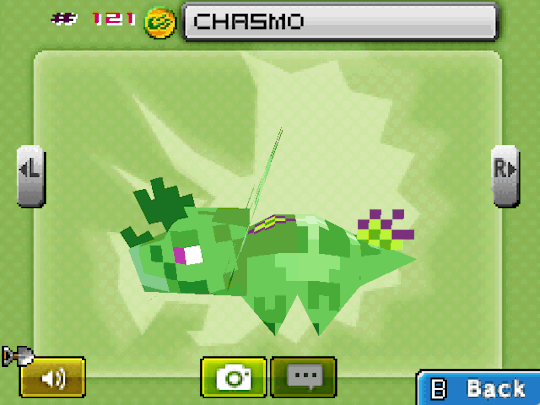
73 notes
·
View notes
Text
I'm having A Day™, so here's all of my
Favorite Things <3
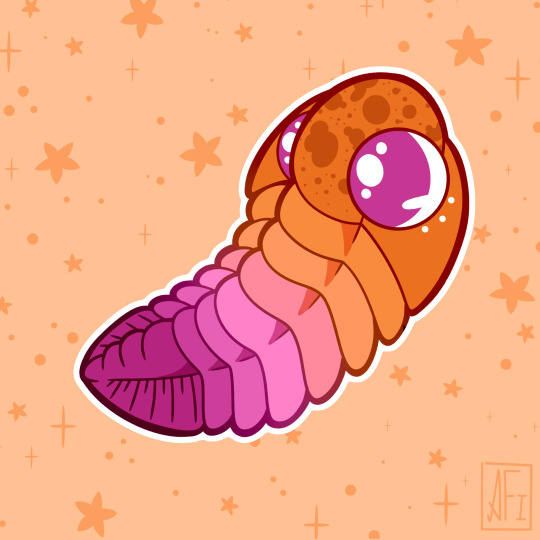


Trilobite: Phacops rana (D) Problematic Fossil: Parvancorina (Pre Cambrian) Fish: Bothriolepis (D)
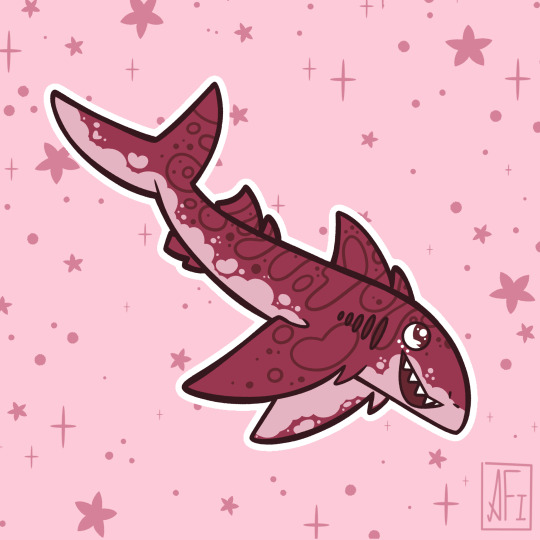
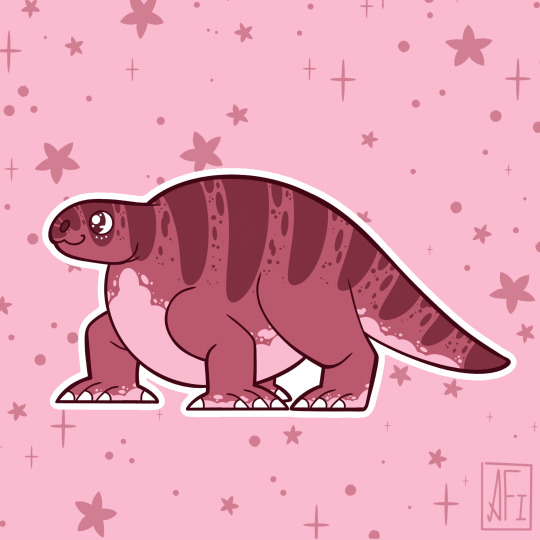
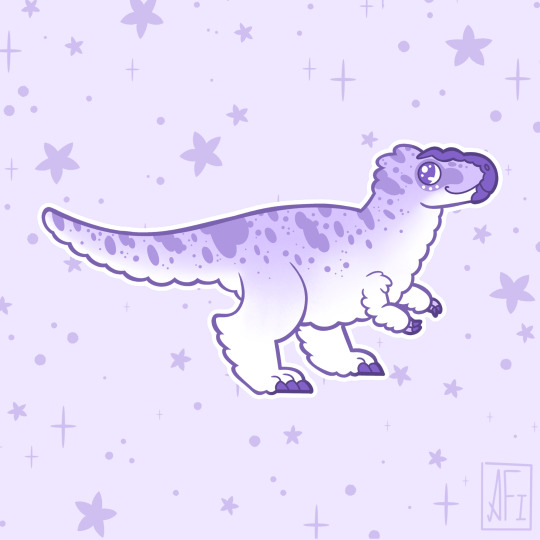
Shark: Cladoselache (D) Misc Reptile: Cotylorhynchus (P) Theropod: Nanuqsaurus (K)


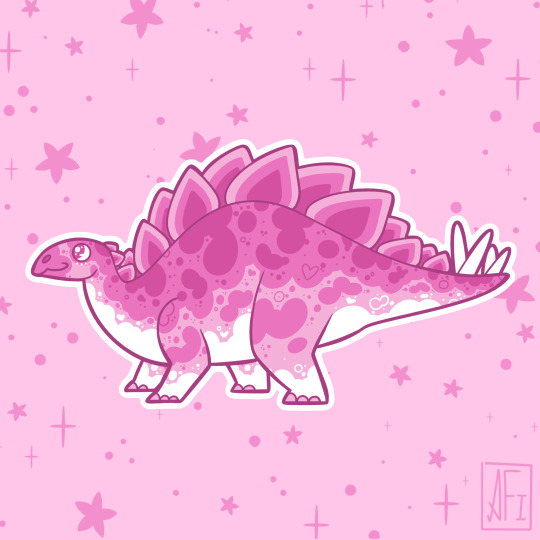
Sauropod: Brachytrachelopan (J) Ornithopod: Parasaurolophus (K) Thyreophoran: Stegosaurus (J)



Marginocephalian: Chasmosaurus (K) Crocodylomorph: Sarcosuchus (K) Whale: Basilosaurus (Pg)
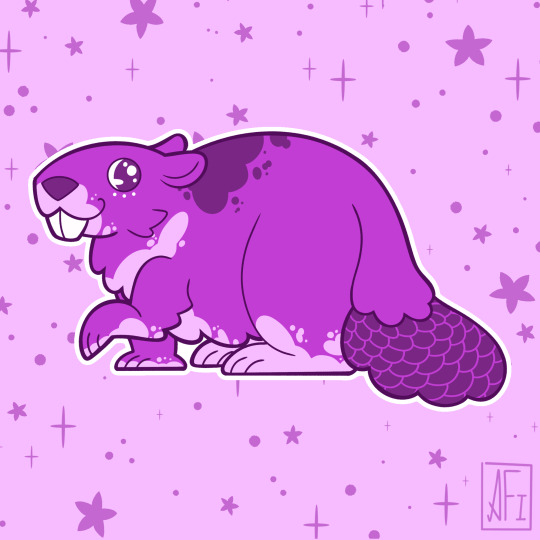
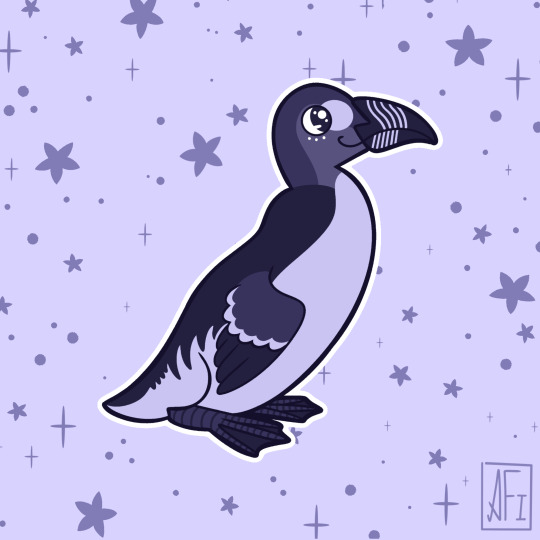
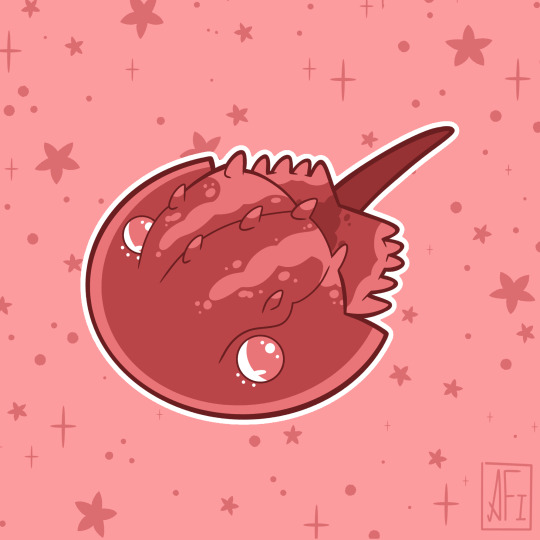
Ice Age Critter: Castoroides (Q) Recent Extinction: Great Auk (H) Modern Critter: Horseshoe Crab (H)
Stickers || Phone Wallpapers Masterlist
#art#my art#paleoart#paleontology#science#illustration#phacops#parvancorina#bothriolepis#cladoselache#cotylorhynchus#nanuqsaurus#brachytrachelopan#chasmosaurus#sarcosuchus#basilosaurus#castoroides#great auk#horseshoe crab
136 notes
·
View notes
Text
Archovember 2024 Day 3 - Gorgosaurus libratus
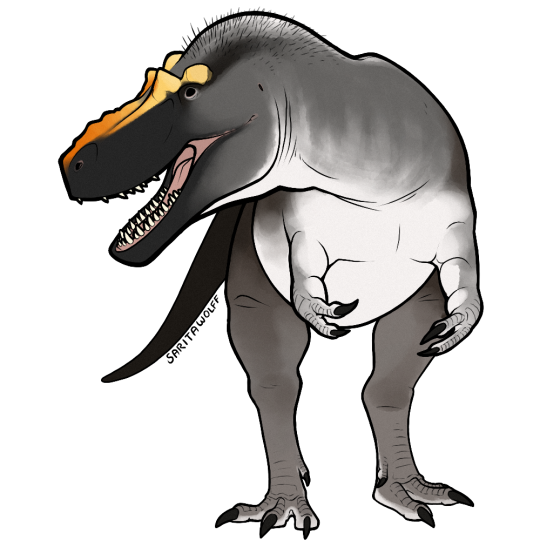
The apex predator of Western North America during the Late Cretaceous was Gorgosaurus libratus. Found so far in Alberta, Canada and Montana, USA, it lived several million years before Tyrannosaurus rex would appear. While it was a tyrannosaurid, it was more closely related to Albertosaurus, so much so that some scientists consider it to be another species of Albertosaurus. Gorgosaurus is the most numerous tyrannosaurid in the fossil record, known from dozens of specimens. This abundance of fossils has allowed paleontologists to investigate Gorgosaurus’ ontogeny, life history and many other aspects of its biology. For example, in 2023, a 5-7 year old juvenile Gorgosaurus was discovered with stomach contents consisting of two intact Citipes juveniles about a year old. This showed that younger Gorgosaurus’ were mostly eating prey much smaller than them, and were probably not hunting in packs, as the meal would not have been large enough to share. That being said, only the remains of the hindlimbs and caudal vertebrae of the juvenile Citipes were present, suggesting that this Gorgosaurus may have had a preference for the muscular hindlimbs. Many Gorgosaurus specimens also preserve evidence of facial scars, a result of intraspecies facebiting.
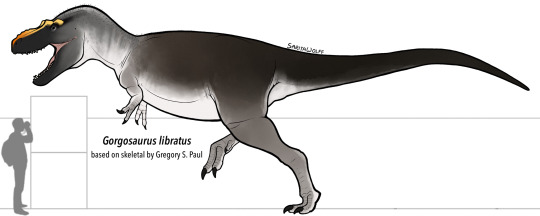
Gorgosaurus would have lived on the coastal plain along the western edge of the Western Interior Seaway, an inland sea which divided North America in half during the Late Cretaceous. The area was subtropical with periods of drought. Conifers would have dominated the forests, while the underbrush consisted of ferns, tree ferns and angiosperms. Gorgosaurus is best known from the Dinosaur Park Formation. Here, it would have lived alongside another apex predator: Daspletosaurus wilsoni. While these tyrannosaurids were roughly the same size, they may have preferred different types of prey, allowing them to coexist without too much competition. And there was a wide diversity of prey here, from many of the most famous ornithopods like Parasaurolophus walkeri, Corythosaurus casuarius, Gryposaurus notabilis, and Lambeosaurus lambei, to beloved ceratopsians like Styracosaurus albertensis, Centrosaurus apertus, Chasmosaurus belli, Spinops sternbergorum, and Vagaceratops irvinensis. There were also ankylosaurs like Anodontosaurus inceptus, Dyoplosaurus acutosquameus, Edmontonia rugosidens, Euoplocephalus tutus, Panoplosaurus mirus, Platypelta coombsi, and Scolosaurus. Pachycephalosaurids included Foraminacephale and Stegoceras validum. Gorgosaurus also shared space with other, smaller theropods, like the ornithomimids Ornithomimus and Rativates, caenagnathids like Caenagnathus, Chirostenotes, and Citipes, dromaeosaurids like Dromaeosaurus and Saurornitholestes, and troodontids like Latenivenatrix and Stenonychosaurus. Dinosaurs were not the only animals here, and Gorgosaurus would have also had to share space with the giant azhdarchid pterosaur Cryodrakon, as well as alligatoroids like Albertochampsa and Leidyosuchus, and choristoderes like Champsosaurus. Gorgosaurus is also known from the Two Medicine Formation and Judith River Formation.

This art may be used for educational purposes, with credit, but please contact me first for permission before using my art. I would like to know where and how it is being used. If you don’t have something to add that was not already addressed in this caption, please do not repost this art. Thank you!
#Gorgosaurus libratus#Gorgosaurus#tyrannosaurids#theropods#saurischians#dinosaurs#archosaurs#archosauromorphs#reptiles#Archovember#Archovember2024#Dinovember#Dinovember2024#DrawDinovember#DrawDinovember2024#SaritaDrawsPalaeo#Late Cretaceous#Canada#USA#Dinosaur Park Formation#Two Medicine Formation#Judith River Formation
119 notes
·
View notes
Text
Hi, I'm back and I drew a Chasmosaurus!
Hey hi!
It's been a while, huh? I'm going to dust off this old blog and see how things go. I like being able to archive my work, and having the opportunity to talk about it is also pretty nice :)
So anyways here's something I drew recently;
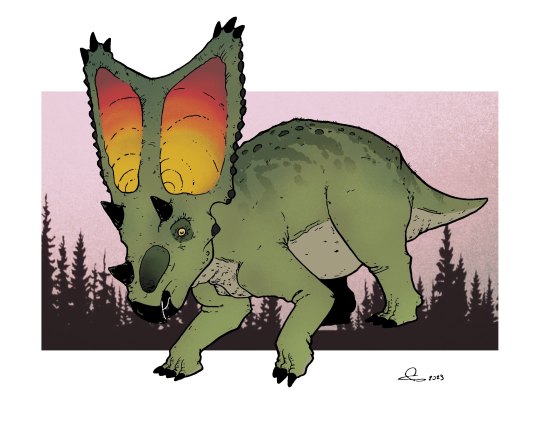
The Chasmosaurus!
Known for its huge, square like head, the Chasmosaurus is a ceratopsid dinosaur from the Late Cretaceous Period in North America.
Recently i went to the Royal Ontario Museum to film a project for school. While i was there i was looking at the Chasmosaurus mount they had on display.
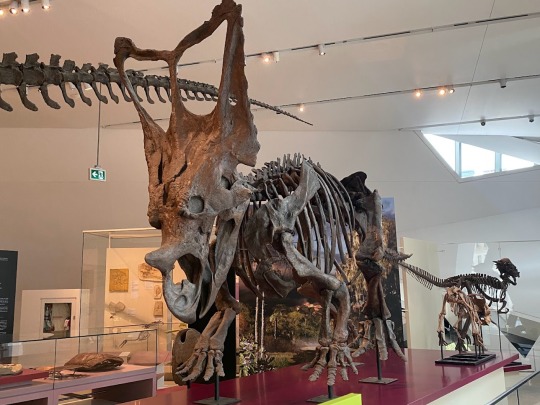
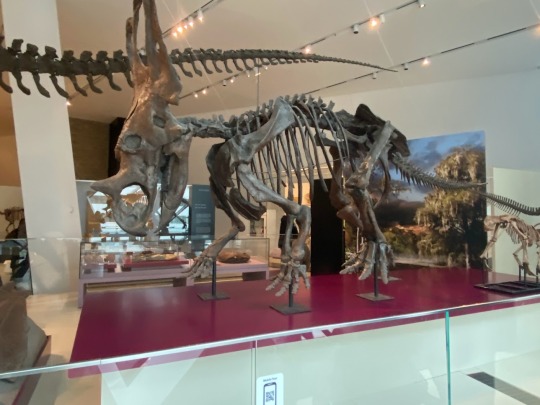
I've seen it before. I love going to the ROM, and I've always liked this mount. It has a nice bit of motion in the pose. When I saw it, it looked as if the left front leg was raised, like it was mid-stride, and the head being slightly cocked down, as if it was grazing or showing off its massive frill.
Looking at it now, I can tell it's more of a flat pose, but the damage was done. I wanted to draw this!
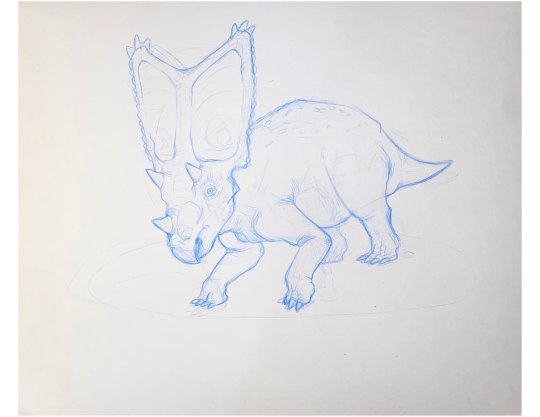
I went home with the idea in my head, and a day or so later, I whipped up this pencil drawing.
I added a few things that the original fossil didn't have, such as the Chasmosaurus's horns. I'll admit I wasn't sure whether this was a male or female fossil, nor that the horns could've been lost to time on this specimen. I also added spikes/horns on the side of the frills that the original fossil also didn't have. I also included small hints of picpycnofibers on the back of the animal, a trait that many ceratopsians had.
when I was happy with the pencils, I moved onto the inks
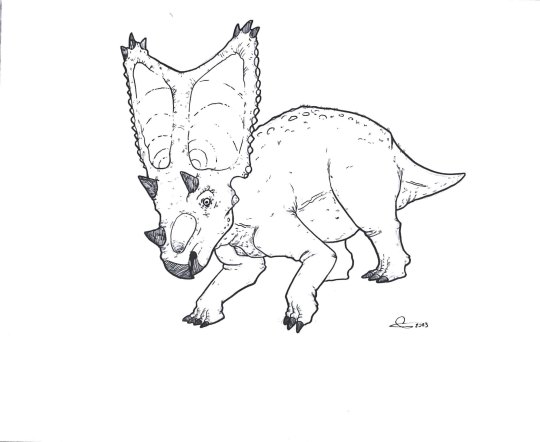
I had fun with this. I live streamed the inking process over on my Instagram (@giaccosketch) i used two zebra brush pens to ink this.
and then I cleaned it up in Photoshop
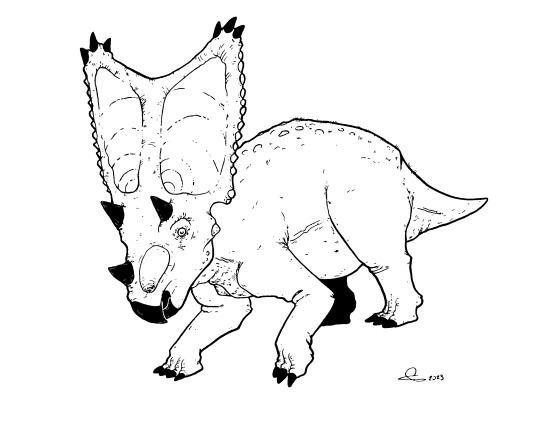
BAM!
Blacked out some of the cross-hatching, as it didn't really translate well in the scan. I also cleaned up some of the lines and scan debris. I think I did a good job!
After I was done, I sent this over to Procreate and coloured it all in. I used a colour palette I made a while back for some fan art.
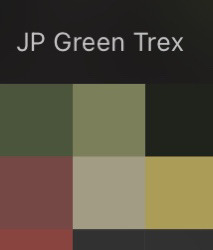
After some time, the final product came out, and I was really happy with it! This was the first time in a long while that I went through a whole process like this for a piece, and I think I'm going to do it again really soon.
Thanks for reading; I hope you liked what I had to say. See you next time!

12 notes
·
View notes
Text
Why is it that Pachyrhinosaurus continues to get the all-brown treatment more than any other ceratopsian I can think of? There are a few toys I saw on google images that have some interesting patterns to them but stay in the green and brown, maybe a rusty red-orange colour, sort of territory. I saw one with some nice oxidized copper sort of colours which was cool. After the 30th result I finally got some really bonkers colours and super interesting patterns.
(For these counts I’m excluding skeletals & fossils)
Centrosaurus also doesn’t have it great, but some blue shows up by result 12, and the 13th was all greens and blues with white stripes.
Chasmosaurus gets blue in there by result 2, and a beautiful bright red pattern on its frill by result 6.
Albertaceratops gets blue and yellow by result 6, red blue and white by 7, and an entirely red head by 11.
Styracosaurus gets red in the first, blue in the second, black and white striped faces by 5, all black and white with stripes and speckles by 11, red orange and teal by 25.
Like what the heck, right?
#dinosaurs#paleoart#ceratopsians#ceratopsia#dinosauria#pachyrhinosaurus#everyone go make a colourful pachyrhinosaurus#they deserve to be pretty too
1 note
·
View note
Text
Prehysteria! (1993)

Do you ever feel like going back and revisiting that one obscure movie you saw as a kid that no one else has ever heard of but you know for sure exists? I distinctly remember seeing Prehysteria! as a child. Well, at least one of the three movies. All I remembered were those awesome miniature dinosaurs. I couldn’t recall ANYTHING about the plot… and there’s a reason for that.
Slimy museum curator Rico Sarno (Stephen Lee) returns from an expedition in South America with five mysterious eggs. When he accidentally swaps coolers with Frank Taylor (Brett Cullen), the widowed raisin farmer and his kids - Monica (Samantha Mills) and Jerry (Austin O’Brien) - discover that their dog is now the proud mother of 5 miniature - but fully-grown - dinosaurs!
The film is basically a mix of Gremlins and Jurassic Park but without any edge and only the blandest of human characters to keep the plot moving. I’m sorry, 6-year-old Adam, but this movie is bad. It isn’t devoid of merit, but it's sub-par entertainment, even for kids.
The best - and really, only redeeming - element of Prehysteria! is the dinosaurs. Even then, a lot more could’ve been done with them. Jerry and Monica’s new pets - Tyrannosaurus Elvis, Brachiosaurus Paula, Stegosaurus Jagger, Chasmosaurus Hammer and Geosternbergia Madonna - are pretty neat in a few ways. Of course, there had to be a t-rex and I wouldn't consider a stegosaurus an obscure species of dinosaur, but the rest are fairly unique, which will please amateur archeologists plenty. The creatures are brought to life with terrific puppetry and stop-motion effects. Considering the film’s low-budget (which shows whenever the use of a green-screen is required), the pint-sized thunder-lizards look great. If only the beasts were given any personality. At the end of the day, it hardly feels like you get to know them at all. It's a shame because the humans who adopt them? They’re complete throwaways who hardly convey the genuine sense of wonder you’d expect from meeting actual dinosaurs, miniature or not.
The unique animals are thrown in a plot that’s so generic it’s hard to care. Rico Sarno is a one-dimensional greedy… museum curator? Huh? The only ones stupider than him are the two goons he hires to help him steal the dinos: Ritchie (Stuart Fratkin) and Louis (Tony Longo). They’re so dumb even a kid could tell the peril in this film is non-existent. The kids are a bit better, I guess, but they’re just typical “younger brother who doesn’t like his older sister” type. The dad is another kind of enigma. He sells fossils to the museum - an opportunity to make doe eyes at Vicki (Colleen Morris), who works at the museum’s desk - but has no interest in dinosaurs whatsoever. It just feels weird. How does he even know what he’s digging up if he has no interest in archeology? I guess we can talk about her too. It’s no spoiler that she ends up on the Taylors’ side against meanie Mr. Sarno when she learns he wants to exploit the dinosaurs for money. As soon as you learn Frank is widowed, you know that means they’ll end up romantically involved. There are no surprises at all and the conclusion is so hurried some of it doesn’t make sense.
You might wonder if I’m upset at a “treasured memory” getting debunked. I’m not. I had a good time with the movie back then and I had a bit of fun with this rewatch… if only because it made me appreciate how much my taste has evolved. I think the funniest thing about Prehysteria! is that while all of the dinosaurs are named after famous musicians, only Elvis contributes to the soundtrack. Even then, it might’ve been an imitator. This movie does not have the budget for Madonna, not by a long shot. All it had was the money to make the dinosaurs look good. That's not enough. (September 25, 2022)

#Prehysteria!#movies#films#movie reviews#film reviews#Albert Band#Charles Band#Pete von Sholly#Greg Suddeth#Mark Goldstein#Brett Cullen#Colleen Morris#Samantha Mills
0 notes
Text
I want to know more
At the Academy of Natural Sciences of Drexel University, we have a Chasmosaurus skeleton.
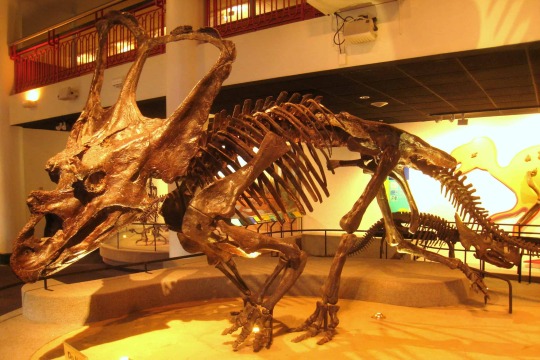
And it has pretty awesome bone pathology. It's got arthritis in its thumbs, damage to its lower back from a crushing injury, and it's left eye-horn is very gnarly.
But trying to find more information on a specific specimen of something not called Tyrannosaurus is extremely difficult for a layman. Anyone got any leads on what the specimen is even called? I want to learn more about its bone pathology, darn it!
105 notes
·
View notes
Note
If it hasn't been done yet, perhaps something on Chasmosaurus?
Ooh good choice!
How about a historical photo this time around?
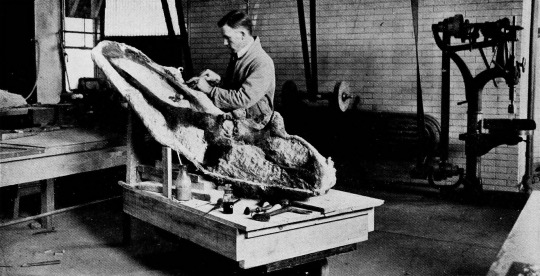
[ photo source ]
Here's George F. Sternberg (the same man who discovered a Xiphactinus audax with a recently eaten Gillicus arcuatus in its stomach!) preparing the skull of a Chasmosaurus belli aaall the way back 1914.
#ask#majingojira#Chasmosaurus#Dinosaur#Palaeontology#Paleontology#Cretaceous#Fossil#Prehistoric#Mesozoic#Ceratopsian#Photo#George F. Sternberg
57 notes
·
View notes
Photo


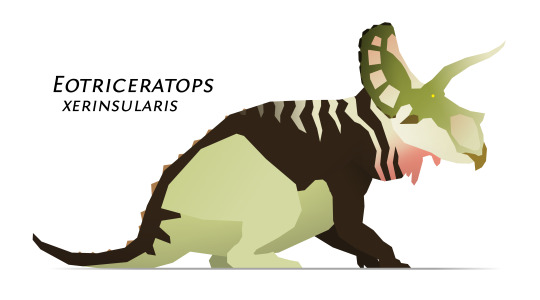
So, now that school has come to an end and I have free time again, I’ve started delving back into the more stylised, angular art that I did a lot of a while ago. Particularly, I’ve been refining the style and making it a bit simpler, which I think helps keep the silhouette and colours clear without cluttering it up with more sharp lines.
I’m not sure why I chose to make ceratopsids a theme with these, maybe because of their diverse headgear and the opportunities for doing fun stuff with colour that it presents? I just really like ceratopsians but I suck at drawing them ordinarily so doing them in a more simplified style was a bit more comfortable. They’re just an excellent shape.
For references, I used Scott Hartman’s Albertaceratops and Chasmosaurus skeletals, and GetAwayTrike’s Eotriceratops skull. Made digitally with Krita.
#dinosaur#paleoart#paleontology#ceratopsid#albertaceratops#chasmosaurus#eotriceratops#fossils#palaeoblr#digital art#my art
367 notes
·
View notes
Photo

I realize I have not done one of my #rainbow #fossil #drawings in a while. So here is a start of various #ceratopsian skulls in my #sketchbook . . . #wip #workinprogress #cerapod #einiosaurus #centrosaurus #chasmosaurus #dinosaur #dinosaurskull #dinosaurbones #dinosaurfossil #fossils https://www.instagram.com/p/B0zV4_rH7wO/?igshid=gja8yvaa1sqv
#rainbow#fossil#drawings#ceratopsian#sketchbook#wip#workinprogress#cerapod#einiosaurus#centrosaurus#chasmosaurus#dinosaur#dinosaurskull#dinosaurbones#dinosaurfossil#fossils
2 notes
·
View notes
Text
What are the New Discoveries About All Types of Dinosaurs Are Emerging?
Do you discover something new and exciting on planet Earth, like finding dinosaurs? Well, these amazing creatures that once roamed our world millions and millions of years ago are full of surprises, and recent research brings into light all types of dinosaurs. Let us dive in, shall we, to find interesting discoveries that shape the pictures of these giants? Read full blog here :- https://fossilageminerals.medium.com/what-are-the-new-discoveries-about-all-types-of-dinosaurs-are-emerging-a045da0eaf27
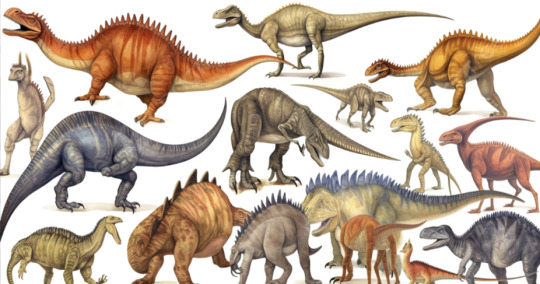
#dinosaur fossils#ammonite fossils#mammal fossils#fossils#spinosaurus fossils#buy real fossils#dinosaurs#chasmosaurus fossils#fish fossils#edmontosaurus teeth
2 notes
·
View notes
Text
It Came From The Wastebasket #02: What Makes A Monoclonius?
The first fossil remains of Monoclonius crassus were discovered in the Late Cretaceous Judith River fossil beds (~75 million years old) in 1876 in Montana, USA. It was one of the many dinosaur species hurriedly named as part of the Bone Wars, and was described based on a mixture of bones from several different sites.
At first much of this dinosaur's anatomy was poorly understood, and at first it was misidentified as a hadrosaur. The skull remains were fragmentary and ceratopsians hadn't yet been identified as a group, so Monoclonius' horns weren't even recognized as being horns and a piece of the frill was initially misinterpreted as part of a breastbone.
Once the much better-preserved Triceratops was discovered in 1889, and the existence of ceratopsians was recognized, Monoclonius was re-examined and identified as a similar dinosaur – and three more species were quickly described within the genus, also based on very fragmentary fossils.
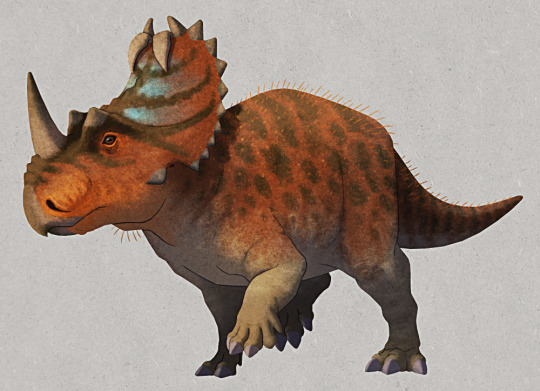
Then for a while afterwards every ceratopsid fossil that wasn't clearly a Triceratops was then just dumped into Monoclonius, quickly turning the genus into a wastebasket full of dubious indistinct remains.
But then…
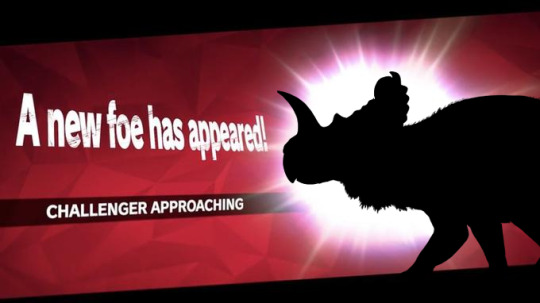
Centrosaurus apertus was named in 1904, from the similarly-aged Dinosaur Park Formation in southern Alberta, Canada. It had originally been one of the various species of Monoclonius, but was now claimed to be different enough to deserve its own separate genus name – and this started a decades-long controversy between several paleontologists.
Over the new few decades arguments went back and forth over whether Centrosaurus was actually valid or if it was just a junior synonym of Monoclonius. As more and better ceratopsid fossil material was discovered several other Monoclonius species were eventually split off into their own separate genera, too, creating Styracosaurus, Chasmosaurus, and the somewhat dubious Brachyceratops. But other new species also continued to be lumped into Monoclonius up until 1990, meaning that over its century of existence this wastebasket taxon had at one point or another contained at least 16 different species.
During the 1990s opinion began to turn against Monoclonius, increasingly regarding it as a dubious name. Its original type specimen was a chimera of multiple different individuals (and possibly multiple different species), and it just didn't have any distinct enough anatomical features to distinguish it from other ceratopsids.
Centrosaurus, meanwhile, was further validated by the discovery of huge bonebeds containing thousands of individuals, making it into one of the best-known of all ceratopsians.
Today Monoclonius' name remains attached to a few fossil specimens, but only the ones that are too indistinct to classify as anything else. Some "Monoclonius" have also turned out to actually be juveniles and subadults of other ceratopsians – it seems many young centrosaurines had a Monoclonius-like stage in their growth, before they went on to develop their own species' distinctive horn and frill shapes.
So Monoclonius may never have been a distinct genus at all – it was just a bunch of different ceratopsian teenagers!
———
Nix Illustration | Tumblr | Twitter | Patreon
#it came from the wastebasket#wastebasket taxon#taxonomy#dubious species#monoclonius#centrosaurus#ceratopsid#ceratopsian#dinosaur#paleontology#art#science illustration#paleoart#palaeoblr
284 notes
·
View notes
Text
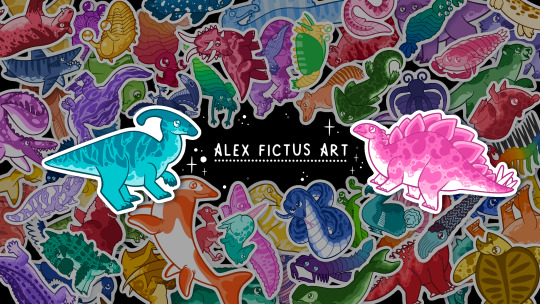
✨Paleo Party Stickers - Patch Notes 1 ✨
Added to Cambrian Era Group: Eldonia
Added to Carboniferous Era Group: Megarachne
Added to Jurassic Era Group: Hybodus, Miragaia, Chungkingosaurus, Gigantspinosaurus, Kentrosaurus, Yi Qi
Added to Cretaceous Ornithischians Group: Wuerhosaurus, Chasmosaurus, Medusaceratops, Centrosaurus, Gryphoceratops, Torosaurus, Atlascoposaurus, Shantungosaurus, Olorotian, Zalmoxes
Added to Cretaceous Saurischians Group: Siamosaurus, Ceratosuchops, Iberopsinus, Vaillabonaventrix, Sigilmassasaurus, Riparovenator, Gigantoraptor
Added to Cretaceous Non-Dinosaurs Group: Repenomamus, Sterpodon
Removed from Cretaceous Non-Dinosaurs Group: Hybodus
Added to Neogene Era Group: Chalicotherium, Deinotherium
Added to Quaternary Era Group: Gigantopithecus
Added to Holocene Era Group: Passenger Pigeon, Alligator Gar, Pelican, Horseshoe Crab, Triops
✨📈Upcoming Queue 📈✨
With pride coming up and the pride cats needing video editing, I may not hit all of these but these are my next priority groups!
Thyreophorans: Jakapil (K), Gastonia (K), Akinacephalus (K), Edmontonia (K), Tarchia (K), Gargoyleosaurus (J), Scelidosaurus (J) Sauropods: Magyarosaurus (K), Xinjiangtitan (K), Saltasaurus (K), Brontosaurus (J)
Theropods: Saurophagnax (J), Monolophosaurus (J), Metricanthosaurus (J), Albertasaurus (K), Struthiomimus (K), Incisivosaurus (K), Atrociraptor (K), Bambiraptor (K), Maip (K)
Pterosaurs: Rhamphorhynchus (J) Ediacaran: Mawsonites, Spriggina, Dickinsonia, Charnia
Paleozoic misc: Cyclida (C), Goniatites (C), Bulbasaurus (P), Diictodon (P)
Mesozoic misc: Juramaia (J), Thalattoarchon (T), Nothosaurus (T)
Cenozoic misc: Dinictis (Pg), Argentavis (N), Pelagornis (N), Toxodon (N), Nuralagus (N), Teratornis, (Qu), Platygonus (Qu), Tuatara (Living Fossil), Tanuki (Living Fossil)
This was a pretty big update! Next sticker patch notes will probably be the upload of the pride cats! If you have any recommendations or requests for the paleo party, send me a message!
All pride cats have been decided and I'm about to start printing them all for my May shop update on Friday May 3!
Date: April 2, 2024
15 notes
·
View notes
Text
I've been watching a playthrough of Fossil Fighters and I think it would be fun to get the game and build a team entirely made up of prehistoric creatures represented in the Pokemon franchise given the obvious similarities. So to that end, I'd at least be able to represent:
Tyrantrum: T-Rex. That's the most obvious one.
Archeops: Aopteryx (Archaeopteryx). Again, easily done.
Aerodactyl: any pterosaur will do. Ptera would be the most basic option.
Cranidos/Rampardos: Pachy (Pachycephalosaurus). That's another easy one to do.
Shieldon/Bastiodon: Shieldon is a Protoceratops (Proto in Fossil Fighters), so that's easy enough. Bastiodon is closest to Chasmosaurus, which doesn't appear in the game, so any large ceratopsid can fill in.
Aurorus: Amargasaurus is in the game as Amargo, though they went with spines and not sails. Which interpretation is correct is still up for debate.
Some of these are a bit more difficult. Lileep/Cradily, Kabuto/Kabutops, Omanyte/Omastar, Anorith/Armaldo, and Tirtouga/Carracosta don't appear to have equivalents since this game mostly revolves around dinosaurs with some other prehistoric beasts from eras later than the Mesozoic thrown in. I haven't looked at the later games yet so if there's something I'm not aware of or missing let me know!
22 notes
·
View notes
Text
Angulomastacator daviesi
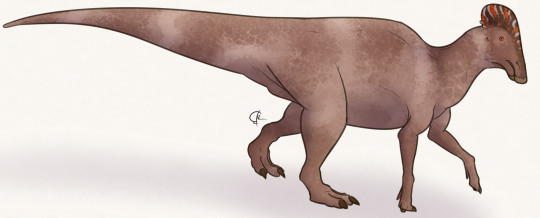
By José Carlos Cortés
Etymology: Bended Chewer
First Described By: Wagner & Lehman, 2009
Classification: Dinosauromorpha, Dinosauriformes, Dracohors, Dinosauria, Ornithischia, Genasauria, Neornithischia, Cerapoda, Ornithopoda, Iguanodontia, Dryomorpha, Ankylopollexia, Styracosterna, Hadrosauriformes, Hadrosauroidea, Hadrosauromorpha, HadrosauridaeEuhadrosauria, Lambeosaurinae
Status: Extinct
Time and Place: All we know is that Angulomastacator lived in the Campanian age, so sometime between 84 and 72 million years ago (though it seems to be around 76 million years ago)

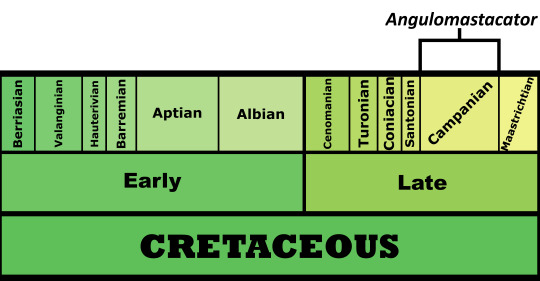
Angulomastacator is known from the Aguja Formation of Texas
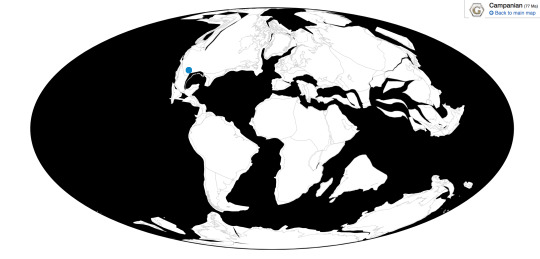
Physical Description: Angulomastacator was a Lambeosaurine - a duck-billed dinosaur with a hollow crest connected to its nose - known from its jaws. Fascinatingly enough, its jaws were weirdly curved downwards, at a 45 degree angle - unusual for a hadrosaur, or really for any dinosaur. As such, it was probably a very highly specialized herbivore. Unfortunately, without more fossil evidence of Angulomastacator, we cannot be certain of the rest of its morphology; what shape its crest may have been, or size of its body, is uncertain. As a Lambeosaurine, it would have been a rather chunky animal, and facultatively bipedal. It probably would have been of moderate to larger size.
Diet: Angulomastacator would have eaten primarily soft plant matter such as ferns and flowers and fruit, but with its downturned jaw it’s uncertain how its diet would have differed extensively from other hadrosaurs; it’s probable that it would have fed on lower lying vegetation than other hadrosaurs, reaching down into a fern and grabbing the leaves while pulling upwards.
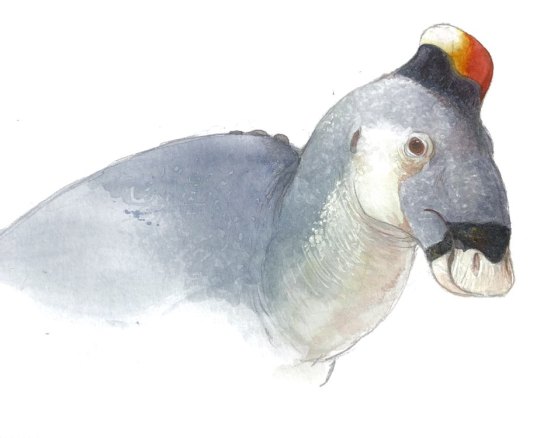
By Ripley Cook
Behavior: Angulomastacator, as a hadrosaur, would have been extremely social, living in very large and complicated family groups. These groups would have cooperatively taken care of their young in large nesting sites. They probably had hollow crests, which would have made distinctive sounds; though the shape of said crest is uncertain. Finally, that crest would probably have been used in display.
Ecosystem: The Aguja Formation represented a coastal plain environment, associated with a muddy transition going from the ocean to narrow river channels. This was an environment filled with many early flowering plants as they grew along the coast. Here there were many other dinosaurs - ceratopsians such as Agujaceratops and Yehuecauhceratops, ankylosaurs like Edmontonia, the pacycephalosaur Texacephale, and another hadrosaur, Kritosaurus. There were also predators such as Saurornitholestes, and omnivores like Leptorhynchos, which would have been dangers for young Angulomastacator. In addition there were turtles and the extremely big crocodilian Deinosuchus which would have fed on adult Angulomastacator as they passed by sources of water.
Other: Angulomastactor is a rare example of a hollow-crested hadrosaur with an interesting feature that isn’t the crest!
~ By Meig Dickson
Sources under the Cut
Horner, John R.; Weishampel, David B.; Forster, Catherine A (2004). "Hadrosauridae". In Weishampel, David B.; Dodson, Peter; Osmólska, Halszka. The Dinosauria (2nd ed.). Berkeley: University of California Press. pp. 438–463.
Lehman, Thomas M.; Susan L. Tomlinson (2004). "Terlinguachelys fischbecki, a new genus and species of sea turtle (Chelonioidea: Protostegidae) from the Upper Cretaceous of Texas". Journal of Paleontology. The Paleontological Society. 78 (6): 1163–1178. doi:10.1666/0022-3360(2004)078<1163:TFANGA>2.0.CO;2.
Longrich, N.R., Sankey, J., and Tanke, D. (2010) Texacephale langstoni, a new genus of pachycephalosaurid (Dinosauria: Ornithischia) from the upper Campanian Aguja Formation, southern Texas, USA. Cretaceous Research. doi:10.1016/j.cretres.2009.12.002.
Sullivan, R.M., and Lucas, S.G. 2006. "The Kirtlandian land-vertebrate "age" – faunal composition, temporal position and biostratigraphic correlation in the nonmarine Upper Cretaceous of western North America." New Mexico Museum of Natural History and Science, Bulletin 35:7-29.
Spencer G. Lucas, Robert M. Sullivan and Adrian P. Hunt: Re-evaluation of Pentaceratops and Chasmosaurus (Ornithischia: Ceratopsidae) in the Upper Cretaceous of the Western Interior. In: New Mexico Museum of Natural History and Science Bulletin 35 (2006), S. 367-370.
Wagner, J. R., and T. M. Lehman. 2009. An enigmatic new lambeosaurine hadrosaur (Reptilia: Dinosauria) from the Upper Shale Member of the Campanian Aguja Formation of trans-Pecos Texas. Journal of Vertebrate Paleontology 29(2):605-611
Weishampel, David B.; Dodson, Peter; and Osmólska, Halszka (eds.): The Dinosauria, 2nd ed., Berkeley: University of California Press. ISBN 0-520-24209-2.
#Angulomastacator daviesi#Angulomastacator#Hadrosaur#Dinosaur#Lambeosaurine#Palaeoblr#Factfile#Cretaceous#North America#Herbivore#Mesozoic Monday#paleontology#prehistory#prehistoric life#dinosaurs#biology#a dinosaur a day#a-dinosaur-a-day#dinosaur of the day#dinosaur-of-the-day#science#nature
130 notes
·
View notes